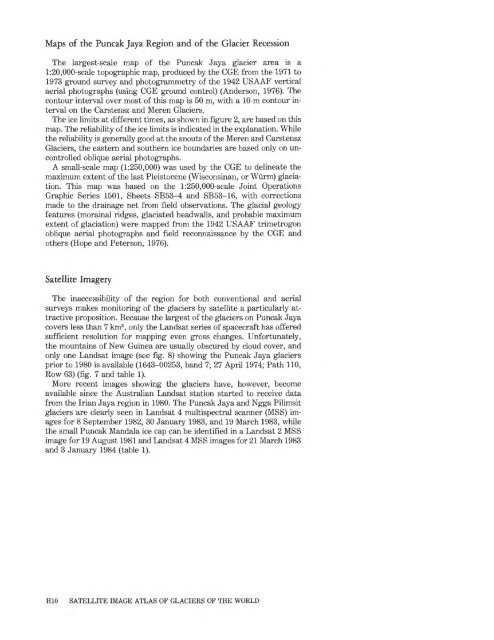IRIAN JAYA, INDONESIA, and NEW ZEALAND
IRIAN JAYA, INDONESIA, and NEW ZEALAND
IRIAN JAYA, INDONESIA, and NEW ZEALAND
Create successful ePaper yourself
Turn your PDF publications into a flip-book with our unique Google optimized e-Paper software.
Maps of the Puncak Jaya Region <strong>and</strong> of the Glacier Recession<br />
The largest-scale map of the Puncak Jaya glacier area is a<br />
l:20,000-scale topographic map, produced by the CGE from the 1971 to<br />
1973 ground survey <strong>and</strong> photogrammetry of the 1942 USAAF vertical<br />
aerial photographs (using CGE ground control) (Anderson, 1976). The<br />
contour interval over most of this map is 50 m, with a 10-m contour in<br />
terval on the Carstensz <strong>and</strong> Meren Glaciers.<br />
The ice limits at different times, as shown in figure 2, are based on this<br />
map. The reliability of the ice limits is indicated in the explanation. While<br />
the reliability is generally good at the snouts of the Meren <strong>and</strong> Carstensz<br />
Glaciers, the eastern <strong>and</strong> southern ice boundaries are based only on un<br />
controlled oblique aerial photographs.<br />
A small-scale map (1:250,000) was used by the CGE to delineate the<br />
maximum extent of the last Pleistocene (Wisconsinan, or Wurm) glacia-<br />
tion. This map was based on the 1:250,000-scale Joint Operations<br />
Graphic Series 1501, Sheets SB53-4 <strong>and</strong> SB53-16, with corrections<br />
made to the drainage net from field observations. The glacial geology<br />
features (morainal ridges, glaciated headwalls, <strong>and</strong> probable maximum<br />
extent of glaciation) were mapped from the 1942 USAAF trimetrogon<br />
oblique aerial photographs <strong>and</strong> field reconnaissance by the CGE <strong>and</strong><br />
others (Hope <strong>and</strong> Peterson, 1976).<br />
Satellite Imagery<br />
The inaccessibility of the region for both conventional <strong>and</strong> aerial<br />
surveys makes monitoring of the glaciers by satellite a particularly at<br />
tractive proposition. Because the largest of the glaciers on Puncak Jaya<br />
covers less than 7 km2 , only the L<strong>and</strong>sat series of spacecraft has offered<br />
sufficient resolution for mapping even gross changes. Unfortunately,<br />
the mountains of New Guinea are usually obscured by cloud cover, <strong>and</strong><br />
only one L<strong>and</strong>sat image (see fig. 8) showing the Puncak Jaya glaciers<br />
prior to 1980 is available (1643-00253, b<strong>and</strong> 7; 27 April 1974; Path 110,<br />
Row 63) (fig. 7 <strong>and</strong> table 1).<br />
More recent images showing the glaciers have, however, become<br />
available since the Australian L<strong>and</strong>sat station started to receive data<br />
from the Irian Jaya region in 1980. The Puncak Jaya <strong>and</strong> Ngga Pilimsit<br />
glaciers are clearly seen in L<strong>and</strong>sat 4 multispectral scanner (MSS) im<br />
ages for 8 September 1982, 30 January 1983, <strong>and</strong> 19 March 1983, while<br />
the small Puncak M<strong>and</strong>ala ice cap can be identified in a L<strong>and</strong>sat 2 MSS<br />
image for 19 August 1981 <strong>and</strong> L<strong>and</strong>sat 4 MSS images for 21 March 1983<br />
<strong>and</strong> 3 January 1984 (table 1).<br />
H10 SATELLITE IMAGE ATLAS OF GLACIERS OF THE WORLD

















